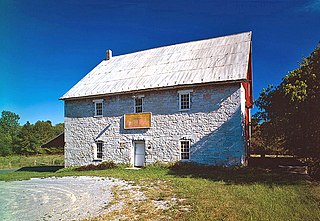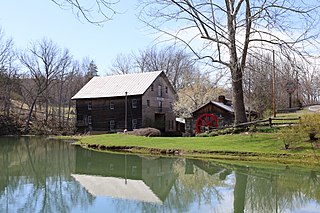Taylorstown is a small community in Loudoun County, Virginia, built on the banks of Catoctin Creek and the surrounding hillside, about two miles (3 km) south of the Potomac River. First settled in 1734, it holds two of the oldest standing houses in Loudoun County, "Hunting Hill" and "Foxton Cottage", directly across the Catoctin Creek from each other.

Shepherd Hall, also known as Monument Place and formerly as Stone Mansion, is a historic house listed on the National Register of Historic Places in the city of Wheeling in the U.S. state of West Virginia. It is located in the Elm Grove area of Wheeling, Ohio County, West Virginia.
The Captain David Pugh House is a historic 19th-century Federal-style residence on the Cacapon River in the unincorporated community of Hooks Mills in Hampshire County, West Virginia, United States. It is also known by its current farm name, Riversdell. It is a 2+1⁄2-story frame dwelling built in 1835. It sits on a stone foundation and has a 2+1⁄2-story addition built in 1910. The front facade features a centered porch with shed roof supported by two Tuscan order columns. The rear has a two-story, full-width porch recessed under the gable roof. Also on the property are a contributing spring house, shed, outhouse, and stone wall.

The Shepherdstown Historic District comprises the historic core of Shepherdstown, West Virginia. The town is the oldest in West Virginia, founded in 1762 as Mecklenburg. No structures are known to exist from the time before the town became known as Shepherdstown. The historic district is concentrated along German Street, the main street, with 386 contributing resources and 69 non-contributing elements. The chief representative period is the late 18th century, with many Federal style brick houses. German Street is also furnished with 19th-century "street furniture" such as metal fences, mounting blocks, wooden pumps and mature trees.

Advance Mills, also known as Fray's Mill, is an unincorporated community in Albemarle County, Virginia.

George Washington's Gristmill was part of the original Mount Vernon plantation, constructed during the lifetime of the United States' first president. The original structure was destroyed about 1850. The Commonwealth of Virginia and the Mount Vernon Ladies’ Association have reconstructed the gristmill and the adjacent distillery. The reconstructed buildings are located at their original site three miles (4.8 km) west of the Mount Vernon mansion near Woodlawn Plantation in the Mont Vernon area of Fairfax County. Because the reconstructed buildings embody the distinctive characteristics of late eighteenth century methods of production and are of importance to the history of Virginia, the site is listed on the National Register of Historic Places despite the fact that the buildings are not original.

The Bunker Hill Historic District is the center of the town of Bunker Hill, West Virginia. Today located on the road called US 11, the town was developed along the Martinsburg, West Virginia - Winchester, Virginia road. Bunker Hill served southern Berkeley County with three stores, six mills, and five churches. It was also home to a significant African-American population.

Mill Creek Historic District is a national historic district located at Bunker Hill, Berkeley County, West Virginia. It encompasses nine contributing buildings, eight contributing sites, and three contributing objects that relate to an early industrial-commercial center in the county. They include: the Mill Creek Bridge, Henry Sherrard Mill, Robert Daniels House, John Gray House, Henshaw Log House, "Springhill", Henshaw Miller's House, "Springfield", Holliday Mill Sites, Bunker Hill Cumberland Valley Railroad Bridge, Stephenson's Tavern, Morgan Park including two State markers and monument (1924) to Morgan Morgan, Elisha Boyd Mill Sites, Joel Ward Mill ruins, Bunker Hill Mill Complex, and Joel Ward House.
Union Bryarly's Mill is a historic flour and grist mill complex and national historic district located at Darkesville, Berkeley County, West Virginia, USA. It encompasses four contributing buildings and two contributing sites. The buildings are the Bryarly Mill, Mansion House, a log smokehouse and combination ice house building, the log miller's house (1751), the site of a distillery and foundation containing archaeological remains. The mill was built about 1835 and is a two-story, three-bay brick building with a gable roof. The Mansion House was built about 1835 and is a two-story, L-shaped frame dwelling on a stone foundation.

Tuscarora Creek Historic District is a national historic district located near Martinsburg and Nollville, Berkeley County, West Virginia. It encompasses 31 contributing buildings and three contributing sites, related to the early settlement and economic development along the Tuscarora Creek. Notable buildings in the district include: Patterson's Mill (1765) and the miller's house, "Elm Dale," the Silber-Walters House, Huxley Hall, site of Patterson's New Mill and miller's house, Hibbard Mill, Tuscarora School, Providence Cemetery, the Mong House, Tuscarora Church (1802), James Noll Shop, Rumsey Mill site, and the poor house or "Mansion House" (1788).

Spring Mills Historic District is a national historic district located near Martinsburg, Berkeley County, West Virginia. It encompasses five contributing buildings, constructed between about 1790 and 1922, and two contributing sites. They include the Falling Waters Presbyterian Church (1834) and Manse (1922) and Stephen Hammond Mill, Miller's House, and Spring House. The buildings are of masonry construction. The sites are the Falling Waters Presbyterian Church Cemetery and the site of Dr. Allen Hammonds House.

Swan Pond Manor Historic District is a national historic district located near Martinsburg, Berkeley County, West Virginia, U.S.A. It encompasses 21 contributing buildings, one site, and one structure, over 2,465 acres. The agricultural district boundaries reflect the Swan Pond Manor land of Thomas Fairfax, 6th Lord Fairfax of Cameron, which he set aside in 1747 as a part of his Northern Neck Territory for his personal use. Notable buildings include the Capt. James Mason House, Kroh-Sprinkle House (1819), Jacob A. Small House, Robert Carter Willis House, Dr. Williams House, "Hollidale," and "Wood Haven" (1895), Raleigh Morgan House. Also located in the district is the separately listed Swan Pond.

North River Mills Historic District is a national historic district located at North River Mills, Hampshire County, West Virginia. The district encompasses 25 contributing buildings and five contributing sites. The district lies along Hiett Run, which empties into the North River, a tributary of the Cacapon River. It has become an industrial ghost town, now visited only by summer residents and tourists. The contributing buildings include the Hiett House with shed and privy; Croston House and barn ; North River Mills Grocery ; Shanholtz House, also known as North River Mills Society for Antiquarian Arts and the Diffusion of Knowledge; North River Mills School ; Miller House and associated outbuildings; United Methodist Church ; Kump House ; and the Moreland House. Contributing sites are the cemetery associated with the Kump House, Miller Mill Site, Shanholtz Mill Site, mill pond, and millrace.

Cook's Mill, also known as The Old Mill and The Greenville Mill, is a historic grist mill and sawmill and national historic district located near Greenville, Monroe County, West Virginia, United States. The district includes one contributing buildings and two contributing structures. The main mill building was built in 1857 on the original stone foundation and site of an earlier mill built in approximately 1796. It is a 2+1⁄2-story, plus basement, hand-hewn post-and-beam building, with massive timbers pegged at their mortise and tenon joints. The district also includes the dam, mill pond, tail race and stream.

The Squire Cheyney Farm is an historic, American farm and national historic district that is located in Thornbury Township, Chester County, Pennsylvania.

Long Marsh Run Rural Historic District is a national historic district located just outside Berryville, in Clarke County, Virginia. It encompasses 315 contributing buildings, 16 contributing sites, and 35 contributing structures. The district includes the agricultural landscape and architectural resources of an area distinctively rural that contains numerous large antebellum and postbellum estates, and several smaller 19th-century farms, churches, schools and African-American communities.

Town of Halifax Court House Historic District is a national historic district located at Halifax, Halifax County, Virginia. The district includes 172 contributing buildings, 1 contributing site, 13 contributing structures, and 1 contributing object in the Town of Halifax. Resources include government, commercial, residential, religious, educational and industrial buildings that date from the early-19th Century to the mid-20th century. Notable buildings include the Rice House, Edmunds/Lewis Office (1869), People's Bank, Beth Car Baptist Church (1892), Christ Episcopal Church, Saint Luke's Christian Methodist Episcopal Church, Dr. Carter House, County Office Building (1915), Town of Halifax Swimming Pool (1930s), Municipal Building/ Fire Station (1950), Halifax Roller Mills (1915), Halifax Planing Mill, Halifax Department Store (1949), and Randolph Theater. Also located in the district is the separately listed Halifax County Courthouse.

Readingsburg, also known as Stone Mill, is an unincorporated community located along the South Branch Raritan River within Clinton Township in Hunterdon County, New Jersey.

The Morgan Morgan Monument, also known as Morgan Park, is a 1.05-acre (0.4 ha) roadside park in the unincorporated town of Bunker Hill in Berkeley County, West Virginia. It is located along Winchester Avenue and Mill Creek. The park features a granite monument that was erected in 1924 to memorialize Morgan Morgan (1688–1766), an American pioneer of Welsh descent, who was among the earliest European persons to settle permanently within the present-day boundaries of West Virginia.

Middle Valley is an unincorporated community located along Middle Valley Road and County Route 513 in Washington Township, Morris County, New Jersey. It is located near Long Valley within the valley of the South Branch Raritan River. The Middle Valley Historic District was listed on the state and national registers of historic places in 1989 and 1990.


















